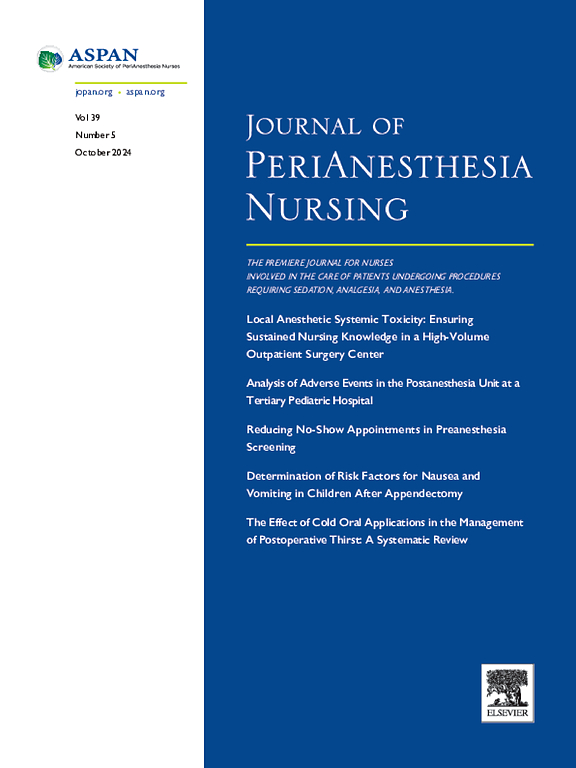Outcomes of Aromatherapy in Nausea and Vomiting After Total Knee Arthroplasty
IF 1.6
4区 医学
Q2 NURSING
引用次数: 0
Abstract
Purpose
The purpose of this study is to assess the effectiveness of aromatherapy for postoperative nausea and vomiting (PONV) after total knee arthroplasty (TKA) under spinal anesthesia.
Design
Prospective randomized four-arm placebo-controlled trials
Methods
One hundred and twenty subjects were allocated to each of the four groups based on the application of aromatic oil in subjects manifesting PONV: group 1 (lavender), group 2 (lemon), group 3 (peppermint), and group 4 (normal saline placebo). Aromatherapy was administered to all subjects immediately after surgery. Antiemetics were provided to subjects with significant nausea or vomiting. The severity of nausea and vomiting in subjects post-TKA was evaluated using the Halpin nausea and vomiting scale (HNV). The HNV and the concentration of antiemetic drug use were evaluated. Subjects’ satisfaction with treatment for PONV was evaluated at discharge.
Findings
HNV scores did not differ significantly between groups immediately after surgery until the third postoperative day (P > .05). The amount of antiemetic drug used in group 3 was significantly lower among the groups (P = .030). The subject satisfaction scale did not differ significantly among groups (P = .837).
Conclusions
Aromatherapy using peppermint oil reduced the amount of antiemetics used to treat PONV after TKA under spinal anesthesia with comparable subject satisfaction. Lavender and lemon oils did not reduce the use of antiemetics after TKA.
芳香疗法对全膝关节置换术后恶心和呕吐的疗效。
目的:本研究旨在评估芳香疗法对脊髓麻醉下全膝关节置换术(TKA)术后恶心和呕吐(PONV)的疗效:前瞻性随机四臂安慰剂对照试验 方法:120 名受试者被分配到四组,每组根据受试者表现出的 PONV 而使用芳香油:第 1 组(薰衣草)、第 2 组(柠檬)、第 3 组(薄荷)和第 4 组(生理盐水安慰剂)。所有受试者均在术后立即接受了芳香疗法。对有明显恶心或呕吐症状的受试者进行止吐治疗。使用哈尔平恶心和呕吐量表(HNV)评估受试者术后恶心和呕吐的严重程度。对 HNV 和止吐药的使用浓度进行了评估。出院时对受试者对 PONV 治疗的满意度进行评估:结果:术后第一天至术后第三天,各组间的 HNV 评分差异不大(P > .05)。第 3 组的止吐药用量在各组中明显较低(P = .030)。受试者满意度量表在各组间无明显差异(P = .837):结论:使用薄荷油的芳香疗法减少了治疗脊髓麻醉下 TKA 术后 PONV 的止吐药量,受试者满意度相当。薰衣草精油和柠檬精油并没有减少 TKA 术后止吐药的使用。
本文章由计算机程序翻译,如有差异,请以英文原文为准。
求助全文
约1分钟内获得全文
求助全文
来源期刊

Journal of Perianesthesia Nursing
NURSING-
CiteScore
2.20
自引率
17.60%
发文量
279
审稿时长
90 days
期刊介绍:
The Journal of PeriAnesthesia Nursing provides original, peer-reviewed research for a primary audience that includes nurses in perianesthesia settings, including ambulatory surgery, preadmission testing, postanesthesia care (Phases I and II), extended observation, and pain management. The Journal provides a forum for sharing professional knowledge and experience relating to management, ethics, legislation, research, and other aspects of perianesthesia nursing.
 求助内容:
求助内容: 应助结果提醒方式:
应助结果提醒方式:


